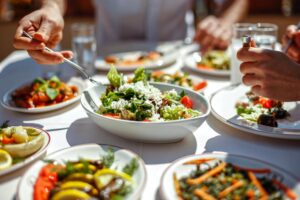
Healthy Dinner : How To Dine Out Without Ruining Your Diet
Once in a while, it is nice to leave homemade cooking and dine outside. However, only a few restaurants serve normal portions to their customers; this will be a challenge if you try to monitor your calorie intake. Other risk you have to face while eating out is the nutritional facts contained in the meals. It is no secret that food served at restaurants generally contains too much fat and sodium, but has very few vitamins, minerals, and fiber. However, if you know some smart tricks, you can still go and dine outside while keeping your diet at the right track.

Go easy on appetizer
Appetizers can boost your calorie intakes up to extreme digits. For instance, twelve buffalo wings may contain 700 calories, eight stuffed potato skins with sour cream contain 1,260 calories, and a fried onion bloom with dipping sauce contains 2,130 calories. For healthier choice of appetizers, you can opt for seafood cocktail, fresh fruit, vegetable juice, raw vegetables with salsa dip, or marinated vegetables. If you prefer salads, avoid fatty choices such as regular cheese, croutons, bacon bits, or high-cal condiments such as mayonnaise. For vitamins, minerals, and fibers source, fill up your bowl with romaine, spinach, or other dark-green leaves instead of iceberg lettuce. For protein source, add legumes (chickpeas or crabmeat) and lean meats (egg whites, chicken breast, or turkey). For calcium source, add yogurt, low-fat cottage cheese, or other low-fat or non-fat dairy products to your salad.
Smart entree choices
For the main course, choose meals with plain meats and vegetables as the main ingredients. When possible, steer clear of ingredients such as butter, cheese, cream sauce, and hollandaise as they add extra fat and calorie to your meal. Meals that contain lower fat generally processed in the terms: broiled, baked, braised, roasted, grilled, stir-fried, steam, poached, or cooked in its own juice. Meanwhile, avoid menu terms such as: fried, deep fried, French fried, buttered, creamed, with gravy, with sauce, alfredo, au gratin, cheese sauce, sautéed, or béarnaise as they contain high calorie and fat. For dealing with big portion, share your entrée with a partner or pack half of the meal in a doggie bag. This way you can save the meal for your lunch the next day.
Desserts and beverages
Fresh fruits are inarguably the best desserts. But if you want ice cream, for instance, opt for low-fat frozen yoghurt, sherbet, or sorbet to avoid more fat intakes. Drinking alcoholic beverages or sodas adds more calories but zero nutrition. The best choice for your meal is plain water with lemon twist.